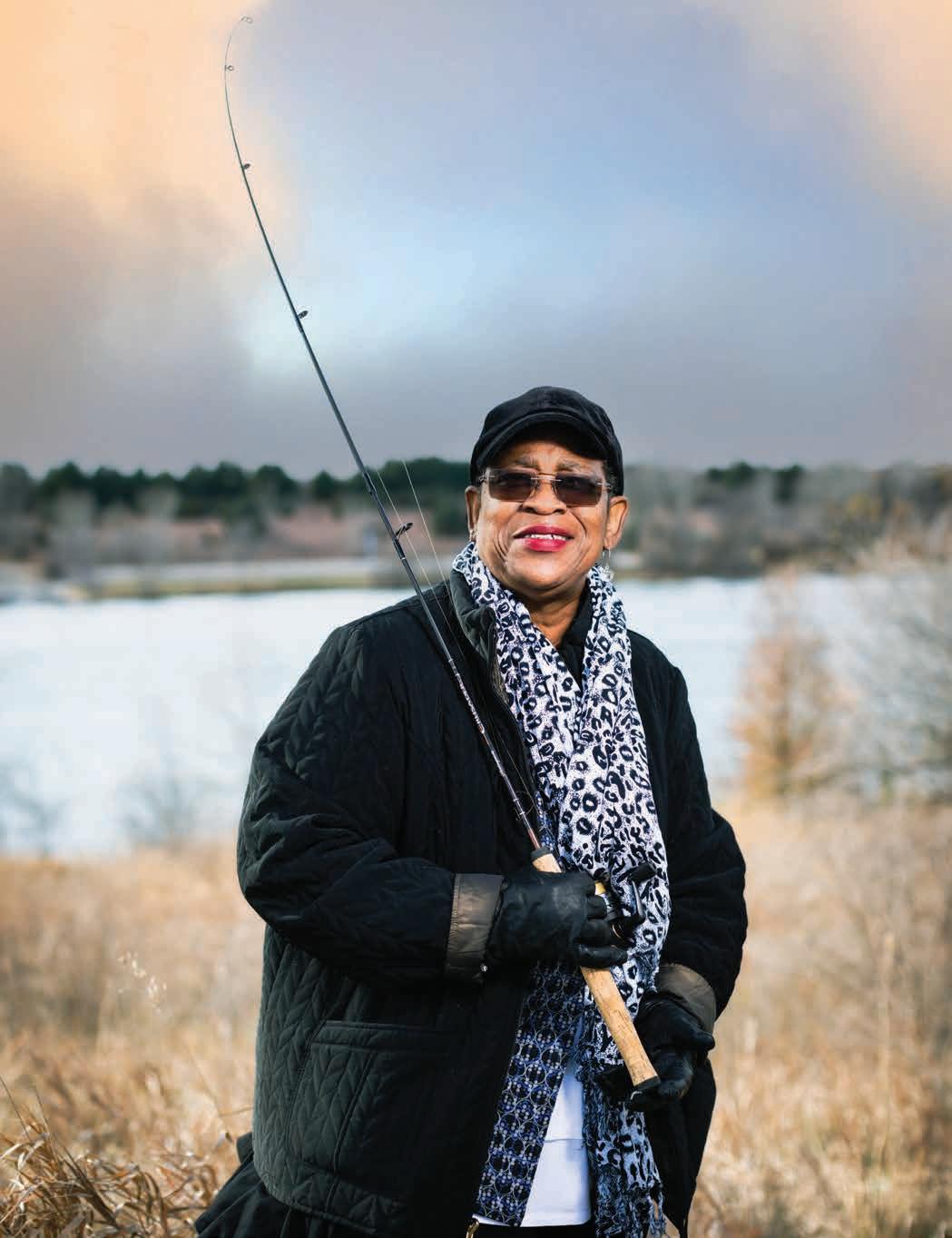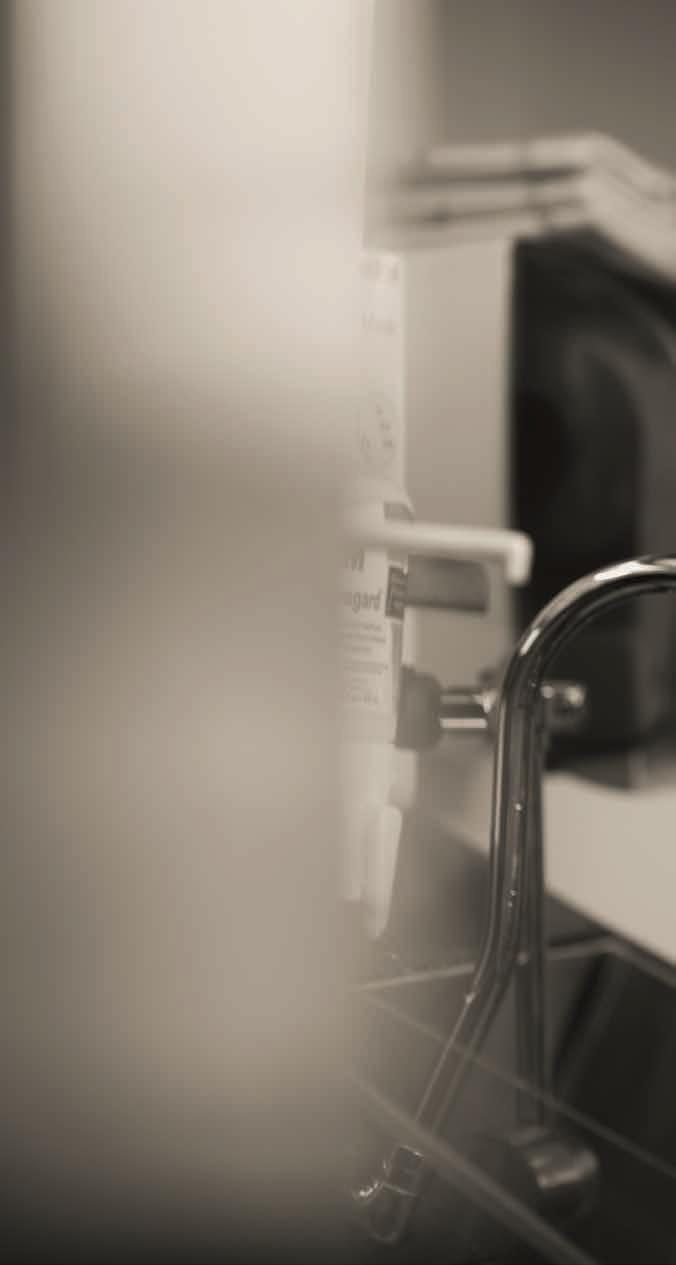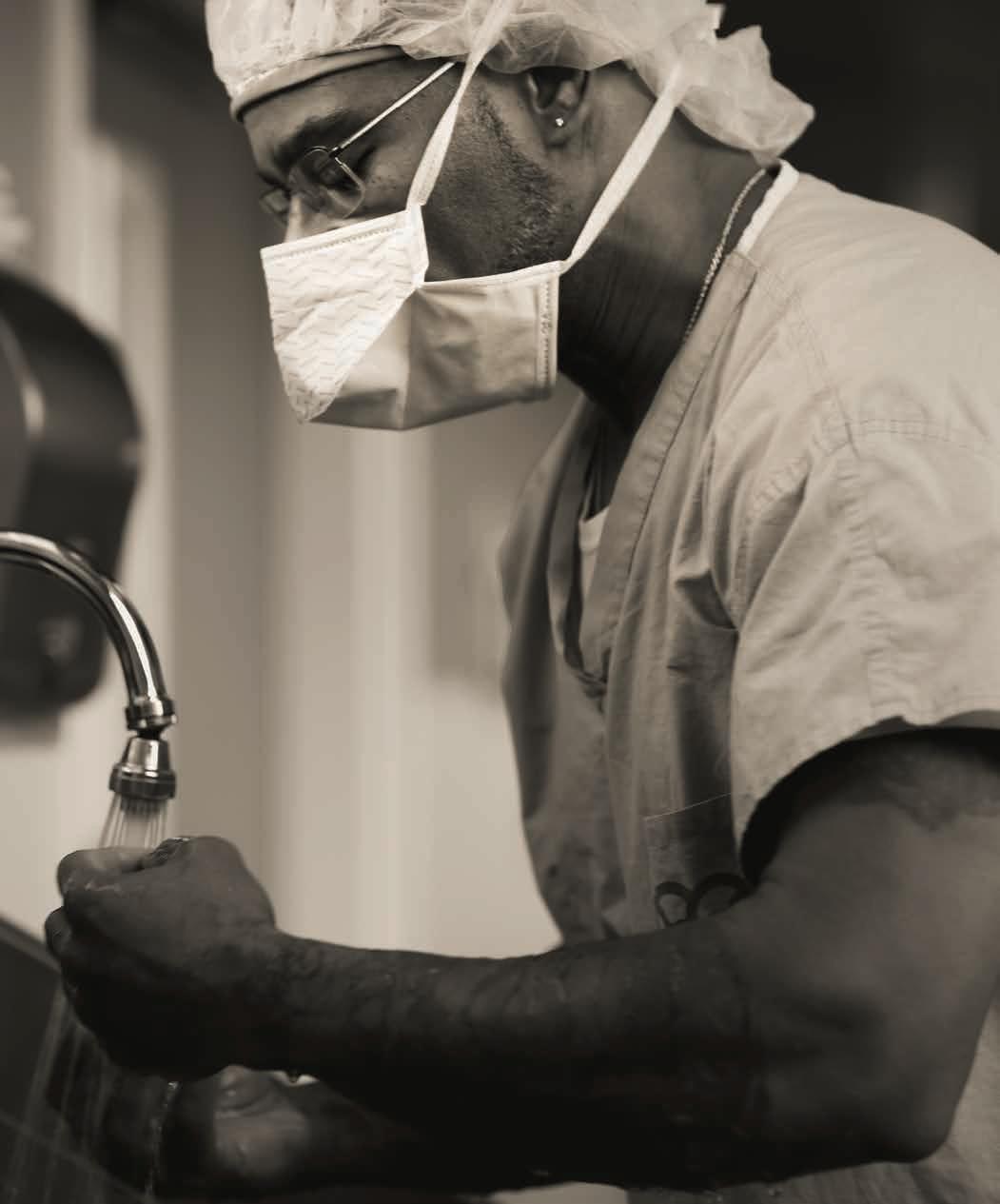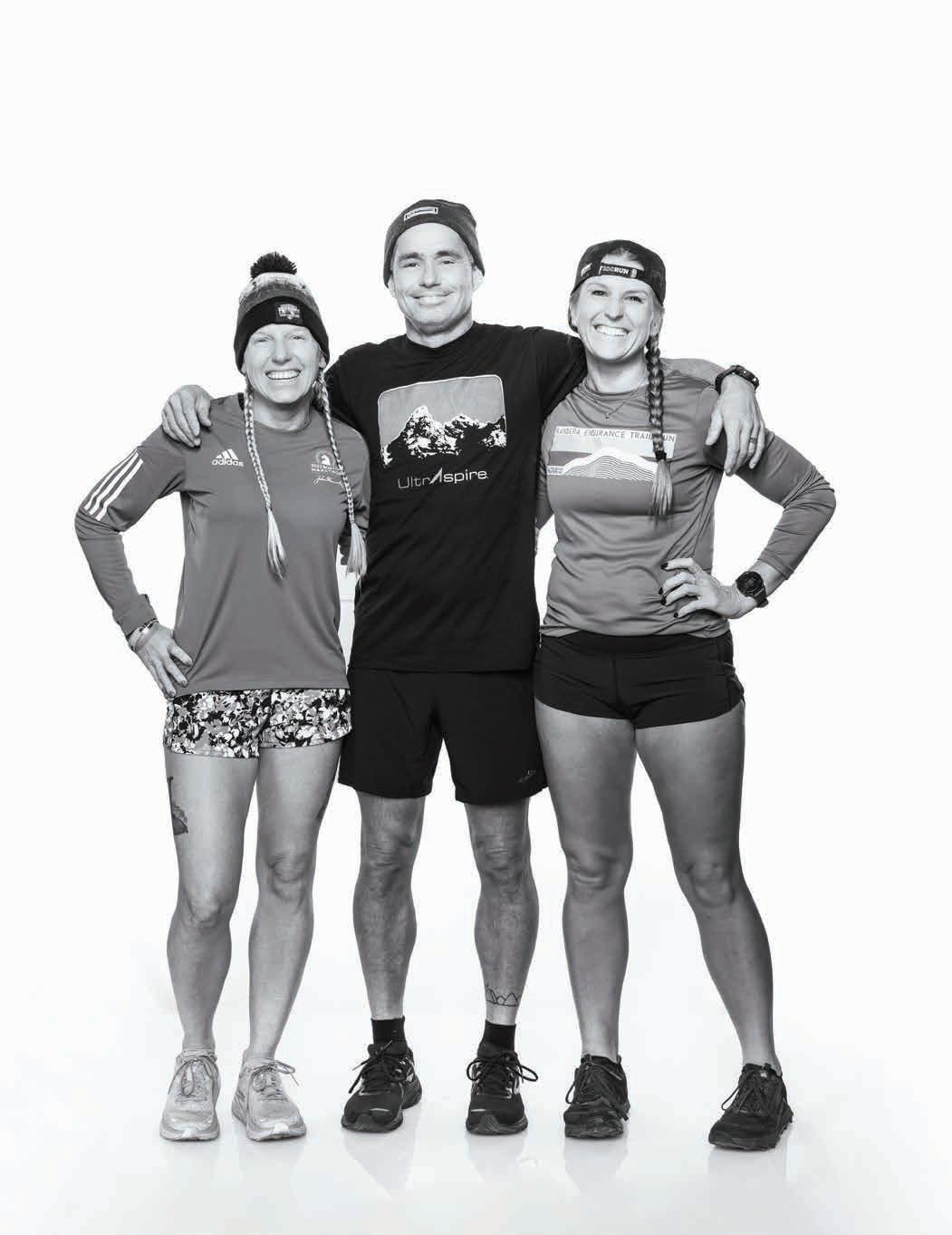
25 minute read
Adventure
“ it was amazing to meet 15 other women going through the same thing i’ve gone through yet, our stories were different. we could all relate to what each other went through.” -Tasha Bang
Breast cancer survivor Michelle Aganor shoulders a fly fishing rod, the quintessential tool provided by nonprofit Casting for Recovery toward reeling in fresh perspective post-cancer.
ensuring breast cancer survivors needn’t wade alone
last September, Michelle Agonor of Omaha stood in fishing waders in a Ponca State Park pond waving a lightweight fishing rod back and forth. More line played out every time she swept the rod forward, a motion that was also exercising her upper-body muscles.
Nearby, 15 other women were doing the same, guided by volunteer fly-fishing experts. The women, all survivors of breast cancer, were learning more than back casts and fly rigging—they were forming bonds over their shared yet nuanced experiences. Originally founded in Manchester, Vermont, in 1996, Casting for Recovery offers free fly-fishing excursions to rebuild and strengthen muscles affected by radiation and surgery during and after breast cancer treatment. To date, about 11,000 women have participated in CFR’s retreats across the nation, including 250 in Nebraska.
“The more important part of the retreat was getting together with people like me,” said Agonor, 63, who works at Union Pacific. “Everybody there involved had had cancer—had been going through it, coming out of it, or starting it. We all had a commonality,” she said.
At 37, Tasha Bang was the youngest survivor in attendance.
“It was amazing to meet 15 other women going through the same thing I’ve gone through, yet our stories were different,” reflected Bang, a perinatology nurse at Methodist Women’s Hospital who completed her treatments last May. “We could all relate to what each other went through.”
“We had the same kind of emotions and thoughts,” Bang said. “Some had been cancer-free for years and they were like, ‘Hey, you’ll get through this.’”
Bang said the casting motions left her a bit sore, not altogether bad news.
“It was a good sore,” she qualified.
According to Faye Nelson, CFR’s national director, the motions required in fly-fishing prove effective physical therapy for those who’ve ungergone surgery, whether a mastectomy, a lymph node removal, or the removal of a breast. She explained that CFR holds more than 40 retreats a year in 39 states, with participants selected randomly from applications submitted from across the nation to attend the free retreats. Those chosen must attend a retreat in their home state—but if their state has no retreat, they can attend one in a neighboring locality.
Omahan Linda Lovgren, head of CFR’s Nebraska chapter, described how each retreat is attended by a physician’s assistant and a psychosocial worker experienced with oncology. They conduct sessions with the women to talk about managing the side effects and what to expect during and after treatment. Questions collected in a box are discussed in a group setting.
“The women learn from each other, as well as the experts,” said Lovgren, who was diagnosed with cancer in 2010. An angler herself, she read about CFR in a fishing magazine and looked into hosting a retreat in Nebraska, which came to fruition in 2011 and has been held annually since (except during the pandemic).
“One thing we know is that 80% of women diagnosed with cancer don’t go to any kind of support group, so to be in a setting like this, you can feel safe asking anything and know that others in the group are going through the same thing,” Lovgren said. “This creates an environment for amazing bonding and friendships.”
She said many organizations and donors contribute to the retreats in Nebraska and other states. These include Cabela’s/Bass Pro Shops, Werner Foundation, Omaha
Beady Bunch, Donna and Ed Robinson, and at least 50 other entities.
Shirley Kelsay, of Falls City, Nebraska, underwent treatment in May 2019 and formed a small support group to talk about cancer. Attending the Ponca retreat expanded that circle. It also taught her, already a skilled angler, a new form of casting.
“It was a little different, a little trickier,” she said.
The retreat was also different in that it was a catch-and-release event, something
Kelsay, 62, is unaccustomed to, as she likes to catch fish to dress and eat.
Another rule was anyone who caught a fish had to kiss it before returning it to the water. Bang thought one she caught was slimy, so she just ran a finger across it.
“I was totally being a girl, just grossed out,” she laughed, adding that she got hooked on fly-fishing in spite of herself.
Nationally, up to 60% of CFR participants continue fly-fishing after the retreat. More importantly, about 96% are inspired to do more activities outdoors. Beyond communing with nature, the retreats have other lasting effects: women feeling their voices were heard, and forming lifelong bonds with other survivors.
Agonor—ho doesn’t plan to fly-fish again but looks forward to more outdoor activity—said of the retreat: “I’ve never met a more willing group of women who really were about helping people navigate future processes of healing.”
Visit castingforrecovery.org for more information.
FEATURE STORY
JULIUS FREDRICK
PHOTOGRAPHY
BILL SITZMANN
DESIGN
MATT WIECZOREK
WILLIE MILLER’S PATH TO HEALING
RE SSURECTED
B Ry all appearances, 2000 was a standout year for Willie Miller. A senior at the University of Nebraska—Lincoln, Miller donned the scarlet and cream as the Cornhusker’s starting fullback, thundering down the field for a career-high 225 yards on the season. Sell-out crowds roared and reveled in the wake of his physicality; pumping legs, heaving shoulders, and cracking helmets rippled The Sea of Red. On the surface, Miller appeared to absorb it all—the fanfare, the impacts, his studies—earning his second First-Academic All-Big 12 award and recognized as a Brook Berringer Citizen Team Member for his dedicated community service. As his tenure as a collegiate athlete drew to a close, the horizon beyond Memorial Stadium’s uprights shone bright and clear. Yet, behind him, darkness lingered. Quietly, it settled at the base of his neck. “When I was starting my junior year, when I started fullback and the season was going really well […] I was the fastest I’d ever been. When it came to hitting in any kind of way, when it came to running the ball, I was definitely at my peak,” Miller recalled, now sporting surgical scrubs over shoulder pads, some 20 years later. “And I can tell you, by the time I got the end of my senior year, I had games where I could no longer feel my arms, or lift them by the end of a game […] being a fullback, you’re a battering ram, face mask to face mask all game long. The crazy thing is, once that [final] game was over, I found out that it was all over, because I was told that I had played through three spinal concussions that year.”

Perioperative registered nurse (RN) Willie Miller scrubs up and prepares to enter the operating room at Omaha's Methodist Hospital.

“B
ack then, with injuries, it was different, you really didn’t sit and wait and let it heal—you played through it,” he said.
Nebraska’s 2001 Heisman Trophy-winning quarterback, Eric Crouch, echoed his former teammate’s assessment.
“I’m all for safety, but back then, it wasn’t at the forefront of thinking. It was a war. It was a warrior mentality,” Crouch said. “It was, sacrifice your body, and your mind, and your spirit, and hopefully if you do that to a certain level, you’re going to have success in your team.”
A warrior’s contract is writ in simple, yet iron-clad terms, well summarized in the Southwest corner of Memorial Stadium: “Not the victory but the action; Not the goal but the game; In the deed the glory.”
As Huskers, Crouch and Miller were bound to this tradition, and fulfilled its agreement with sacrifice, both immediate and gradual. Miller, however, would pay dearly for it—and in the end, receive something of far greater value: redemption.
After graduation, Miller pursued a career in pharmaceutical sales. Cognizant of the effect his sheen as a local celebrity might have on prospective customers, he chose to start anew in Denver, Colorado.
“I’m all about competition. I didn’t want to remain in Nebraska, have people that are just willing to write a prescription because of my name, and that I played football. I wanted to be on the same ground as everyone else,” Miller said. As the years toiled on, Miller’s first marriage buckled, and finally broke under what he described as “a combination of work, stress, drinking, and painkillers.” He remarried and fathered a child, his daughter Regina. The pressure manifested physically. The 250-pound star athlete had become engulfed by a man Miller hardly recognized; one who stared dejectedly back at him from the bathroom mirror. It was 2008, and Miller now weighed over 400 pounds— and life was about to get even heavier.
“That’s when I got in trouble,” Miller said. “I ended up having a road rage incident with a guy and he was in a regular car with his regular clothes. And, it was just a bad day. But every day was a bad day that time period.”
Despite early success in his field, it grew increasingly difficult for Miller to enjoy the fruits of his labor. Month after month, year after year, vertebrae by aching vertebrae, the pain in his neck crept ever downward. Miller sought respite in booze and prescription pain pills, a pairing notorious for slow-burn addiction. A disc replacement operation only quickened matters.
“Honestly, I can tell you, from the time I first took one of those pills, I liked the way it made me feel. It took away my pain, all of my pain, like the mental pain,” Miller confessed. A collision occurred, a volley of words were exchanged. As it turned out, the man in the regular car, wearing regular clothes, was an off-duty Omaha police officer. The following year, a judge ruled Miller guilty of felony criminal mischief—the lowest degree of felony in the state, but damning nonetheless—and sentenced him to 18 months probation.
“Yeah, that was the moment where things really hit the fan,” Miller continued, his voice faltering between acceptance and self-reproach. “That was the first 10 years of that, and I hadn’t had enough punishment, at all. I had too much pride still. So, obviously, when you have that, you lose things; freedoms, everything else. And for me, it was: ‘Okay, my life’s over.’” Miller’s existence unraveled. He lost his livelihood, his family, and even his home. For two years, he scraped by at the Salvation Army.
“In my mind, my life’s ruined, and this the where I’m going to spend the rest of it. I had times where I had been suicidal, I felt I was better than that, right?” Miller recalled. “Because there wasn’t anything positive going on. I felt like anyone I came across, I was just this cancer. I didn’t have anything positive to say to anyone, and by the time they were done with me, they’d just be zapped. So I went down to Mississippi in 2015, because I knew in order to stay alive, I needed to be with my mom. ”
A retired nurse, his mother’s support kept death at bay, and set the scene for a fateful encounter. A longtime fan reached out to Miller over Facebook, after which the two frequently commiserated over shared struggles with substance abuse. One such conversation proved pivotal: it introduced Miller to the organization that would change the course of his life.
“The Nebraska Greats Foundation is set up to help former athletes that attended any college in the state of Nebraska,” explained Crouch, a member of the foundation’s board. “Jerry Murtaugh is the one who started the organization, a former [Nebraska] football player. We help, both male and female athletes with their medical or emergency needs.”
With the support of Crouch, and administrator Margie Smith, whom Miller now describes as his “second mom,” a skeptical Miller worked with Nebraska Greats. To his astonishment, Miller received the back surgery he’d long considered foregone.
Miller’s condition vastly improved as a result. Familial wounds began to heal, and he met the woman that stands by him today—his wife, Karrie. Still, one surgery couldn’t possibly mend 20 years of self-destruction. Miller’s greatest adversary still lay ahead: himself.
“I’m still on all these medications, and all of a sudden my 80 milligrams worth of Oxycontin, combined with wearing a fentanyl patch, is gone,” Miller said. “It didn’t take me long to figure out it did a lot more than numb my pain.”
Those hollow spaces ate at Miller, and he grew desperate to satiate them. He turned to his other vice, and overcompensated to near-fatal effect.

It can be difficult to know where or when to begin a serious discussion about mental health. For many, the stigma that surrounds asking for help prevents them from reaching out to friends and family, even as symptoms mount and begin impacting their livelihood. While newfound understanding has ostensibly improved perceptions surrounding mental illness, the issue remains steeped in stigma, with a “tough it out” mindset still prevailing in a variety of professional and personal contexts. A great many of those touched by mental illness—with conservative estimates suggesting one in five people suffer from depression and/or anxiety—feel isolated and “othered.”
Although the numbers suffering are staggering, finding commiseration, resources, and treatment too often feels beyond reach. Left untreated, depression and anxiety can lead to psychosomatic responses, including cardiovascular disease, malnutrition, and a host of otherwise preventable, life-shortening illnesses. That’s without factoring in that suicide is currently the 10th-leading cause of death in Nebraska overall, and is the second-leading cause of death among young people.
While the nation’s collective mental health endured the challenges of pandemic isolation, economic instability, and political and societal unrest over the past several years, mental health resources haven’t matched the increasing demand. But that’s beginning to change.
On July 16, an easy-to-utilize suicide prevention and crisis hotline rolled out nationally. Dialing 988 works in tandem with the previously existing number, 1-800-273-TALK (8255), and both will bring you to the same qualified and compassionate counselors armed with the tools and training to respond to nearly any mental health crisis. While the program is national, calls are filtered by location data and directed to local responders. Kyle Kinney, program manager of Boys Town’s crisis center, has seen improvement in the accessibility of resources since 988 was incorporated into Boys Town’s existing suite of crisis prevention services.
“We have provided crisis intervention at Boys Town since 2005, as well as offering national backup [for the existing hotline]. New federal legislation took it from a national structure to a local structure, and transitioned what was in place for the suicide prevention hotline,” Kinney explained. “For years, calling was the only available option. We have now implemented a mobile crisis activation, but the goal is for them not to be necessary...[rather] for us to continue assessing safety, deescalating the crisis, creating a safety plan, and helping them navigate resources remotely. Then we always follow up.”
An estimated 97% of calls received by the hotline are handled directly on the phone, according to Kinney, who said, “Increased awareness of the hotline has definitely increased utilization. We had about 30 calls a day for years, and then July 16th, 2022, came and overnight it jumped to 50 to 60 a day. It has stayed pretty consistent since then, and we may see that number grow over time as awareness spreads. But managing to deescalate over the phone really continues to remain the goal, to connect those people with sustainable resources and help within their community.”
“That really speaks to the intent.” Kinney continued. “There are a lot of spokes involved with getting help— sometimes people need a safe place to go, peer support, resource navigation... The crisis line is important, but everything needs to evolve together to create a robust system that grows to meet the needs of the community. There is a big difference between helping someone, and someone feeling helped. Our counselors are truly motivated to help every call that comes in. And that really sets the tone for what happens after the call.”
When isolation is part of the illness, community is the cure. Kinney and his team of counselors assist callers in navigating an often-complex system of care, costs, and insurance deductibles to identify and mobilize a course of action—hopefully leading to long-term and lasting success.
As the state planner for 988, and system of care administrator, Michelle Nunemaker oversees the use of a grant provided through SAMHSA (Substance Abuse and Mental Health Services Administration). This includes reviewing answer rates and other metrics, and evaluating problemsolving with the crisis team.
CONSERVATIVE NUMBERS SUGGEST THAT ONE IN FIVE PEOPLE ARE LIVING WITH SOME FORM OF DEPRESSION OR ANXIETY—FEELING ISOLATED AND “OTHERED”.
“Kyle [Kinney] and I work hand in hand, seeing that this is more than a phone number, but a transition to a full crisis continuum. That ranges from mental health to substance abuse, to counseling callers who are concerned for a loved one’s safety,” Nunemaker said. “I also work with our six regional behavioral health authorities to raise up those community-based crisis services for mental health and substance use respite.”
Once the automated navigation system has matched callers with a qualified local counselor, their task goes beyond talking someone off the ledge, proverbial or otherwise. Sometimes, a compassionate ear is all it takes to get through to an especially difficult day. However, the mental health experts on-call are determined to help ensure that those hard days are fewer and further between.
“Crisis counselors are connecting people with long-term care over the phone. Even our crisis mobile is working to help people find support. We expect follow-up calls and contact to be made. We want to see how the caller is doing, if they’re feeling better, if they connected with the services we helped them find, and then help them overcome any barriers to getting the resources they need,” Nunemaker said. “Providers identify same-day services for medication management, counseling services, and then support and problem-solving for any possible future crisis.” While crisis deescalation is a core function of the 988 hotline, the service is also positioned to reduce strain community-wide via preemptive counseling and a wide network of mental health resources.
“988 has a preventative focus as well,” Nunemaker continued. “The goal is to help decrease folks accessing emergency rooms when facing a crisis. We are also decreasing the response of law enforcement and letting health providers and law enforcement officers do what they need to do, while behavioral health professionals are doing what they are trained to do.”
Helping remove some of the burden on first responders ensures that resources are directed where they are needed most. Additionally, 988 has the capacity to connect callers with Spanish-speaking counselors, veteran support services, eating disorder specialists, substance abuse counseling, financial assistance, and a host of other local, context-specific support options.
If you or a loved one are experiencing a mental health crisis, dial 988 for 24-hour support, counseling, and other resources.
Visit 988lifeline.org for more information.
tThat ultra—the name of any race longer than the 26.2-mile length of a marathon—marked the beginning of Semonell’s journey as an he passing of a loved one can compel some to change their lives. For Jodi Semonell, the death of her father from lung cancer at age 60 in December 2011 put her on a different path from how she had been living—many paths. Spanning countless miles, they’ve tested the limits of her body and mind to metamorphic effect. Describing herself something of a party girl, drinking frequently and smoking up to a pack of cigarettes a day for 25 years, Semonell realized she didn’t want to be end up like her father. ultra runner. Since that fateful race in December 2015, she has His mortality raised a mirror to Semonell’s own lifestyle, reflect- run in every Hitchcock 100, including one where nearly 8 inches ing a predictable fate she simply could not accept. Determined to of snow fell the night before the race. change course, she began running regularly to get fit.
At the time, Semonell didn’t consider herself much of a runner, though she had participated in a few 5K and 10K races. But after her father’s death, she felt the need to challenge herself. She set her sights on running in the Lincoln Marathon the following May.
On her first day of practice, she ran roughly 3 miles. In a few weeks, she ran around Lake Zorinsky near her Omaha home, a distance of about 8 miles. “We all had to wear screw shoes during that race just to stay upright,” she said of the cleats that had been attached to the soles of the shoes. “Ice is the only thing that scares me on the trails.”
Because runners take at least 18 hours to complete the Hitchcock 100, they must navigate portions of the course after nightfall, carrying lights to illuminate the trails. While some runners use headlamps, Semonell prefers to wear one around her waist.
“I thought, ‘Oh my gosh, I ran the entire day,’” recalled Semonell, who kept running further and further with each passing week.
“I wasn’t very good. I’d just plod along and get it done,” Semonell said. Running on streets, in marathons, and Zorinsky’s paved trails for training, she began suffering shin splints–inflamed muscles of the lower legs. When she sought medical advice, her doctor asked her if she had considered running on dirt trails.
“I thought that sounded awful,” remembered Semonell, now 50 and an employee with Conifer Health Solutions.

Nevertheless, she signed up for a 50-mile race along the dirt trails of Hitchcock Nature Center—one of several races of varying lengths being held over a winter weekend at the center in Iowa’s Loess Hills.
“I went to Hitchcock to practice and thought, ‘Oh my God, this isn’t even running,’” she said, noting that the pace of trail-running was slower than that of a marathon.
While training at Hitchcock, Semonell met some long-distance runners and earnestly listened to them describe participating in 100-mile races. She requested a switch to Hitchcock’s 100-mile race as a result, going the distance against competitors from across the country. “It’s so bright, it’s almost like driving a car,” she observed.
Ultra runners always carry their gear, including jackets, nutrition, and water, even in the races that have aid stations, as those can be up to 25 miles apart.
“In a 100-mile race, you need at least 3 liters of water,” she explained. “In a 200-mile race, you have to also carry pants, a rain jacket, a spare lamp, and spare battery. That’s about 10 to 15 pounds worth of stuff, and it’s for days. A 250-mile race can take you 90 to 110 hours to complete, and while you might wear a parka and hat on a 20-degree morning, you still have to carry those in the afternoon when it’s 40 to 50 degrees.”
Although Semonell no longer endured the impact of pavement, the pains in her legs continued. Having qualified for the 2017 Boston Marathon, she thought it was time to bring in some outside expertise and hired a running coach licensed in physical therapy.
“I told her my goals, which were that I had a race coming up in Des Moines and the Boston Marathon in April, and she says, ‘I’m going to give you a training plan. Each day of the week, you’re going to do x-number of miles at this pace, and six hours at Hitchcock on Saturday and five hours on Sunday.’ Since then, I’ve gotten faster, run further, and have not been injured,” Semonell said. To date, she has finished at least 50 marathons, 15 100-mile races, and four races that were at least 200 miles long.
FEATURE // STORY BY MIKE WHYE ultra running
a step beyond the marathon

Marathons and Ultras
Just as marathons have spread since the first modern one was held in London in 1896, ultras have too. A precursor to ultras called “pedestrianisms” date back to 18th century England, exported to the U.S. after the American Civil War. The first true ultra marathon was 55 miles long and held in 1924 in South Africa. In the U.S., the first 100-mile ultra was held in California in 1974.
Ultra Running magazine reported that a little over 34,000 ultra runners were competing in the U.S. in 1996. In 2021, 611,098 people were engaged in ultras, one-third of them women. Similarly, ultra race events have exploded from 220 in 2000 to 2,237 in 2021.
Ultra Races— Long and Demanding
Last August, Todd Nott, 58, a retired high school teacher and coach in Plattsmouth, ran in the Badwater 135, which some have branded ‘The World’s Toughest Foot Race.’ Nott started at the lowest point in North America, 282 feet below sea level in Death Valley National Park, and came in eighth out of the 100 chosen to participate—crossing the finish line 8,360 feet above sea-level, along the slope of Mt. Whitney. He had run for 25 hours and 47 minutes in temperatures reaching 130 degrees Fahrenheit.
Two months later, he ran the Moab 240, a race that crossed red-rock canyons, mesas, and mountains in Utah.
Phantoms of the Trail
The night before the Moab race, Nott didn’t sleep well, getting only an hour of sleep. After completing about 200 miles, he somehow managed to wander off the marked course. He had a map app on his phone, but its battery had died. Eight to 10 hours passed before race officials found him back on the course, trudging down a mountain.
“I was out of it,” he said, noting visual hallucinations plagued his descent. As he traveled along a road, bushes appeared to him as animals including elephants and monkeys. He even saw Macy’s Parade balloons. At one point, he thought he was hiking with his kids. He wanted to run to a town that didn’t exist. The course was so remote, he said, that no towns were anywhere near it. She continued to run more frequently and over greater distances, eventually falling in with the ultra community. In February 2019, she ran her first ultra in Arizona.
“I’m never going to be in the top 10 or top 40% of a race,” said Welch, who finishes any race she runs. “I’m a completer, not a competer.”
At times she has served as a “pacer” for other runners, wherein an unregistered runner helps a competitor maintain safety, momentum, and morale.
“I’d rather run with someone as a pacer than run the race itself because it’s like your job to make sure your runner is safe,” Welch said. “Having a pacer is just for sheer safety. It’s nice to have someone with you to make sure nothing happens.”
As a nurse practitioner at Immanuel Pathways PACE Center, Welch said much of her life is devoted to taking care of people—her frequent role as a pacer simply an extension of what she already does. During a friend’s first 100mile run, she helped keep him on the trail, stay awake, and maintain food and water levels.
“This was my first over 200 miles,” Nott said. “It used to be a big deal to do more than 100 miles. The long ones are getting more popular.”
Running since his high school track days, he started with 10Ks, half-marathons, and triathlons before taking on marathons.
“I thought I’m not getting any faster in marathons, so I did my first ultra in 1996,” he said.
Out of the 800-plus races he’s run since, more than 140 have been ultras. To practice, he runs in the hills near Plattsmouth and enjoys training in Platte River State Park, Hitchcock Nature Center, and Swanson Park in Bellevue. Nott runs 60 to 90 minutes on weekdays and three hours on Saturdays and Sundays. He also bikes, swims, and lifts weights a couple times a week, and he started yoga this fall.
Like many other ultra runners, he prefers trails to pavement.
“They’re so much easier on your body,” he said, also noting the rambling variations of the trails exercise many muscle groups.
“It was kind of comical, but it was scary,” he said.
People faded in and out of view. He called to some for help, but received no answer. Though he was hungry and thirsty, Nott attributes his warped mind-state to sleep deprivation.
“In retrospect, I should have rested somewhere,” he said. “In every race you learn something. I learned my lesson.”
Omahan Amber Welch, 37, has had similar hallucinations while running extreme distances. During a night run, she ‘saw’ people in tents who were laughing at her alongside rabbits that didn’t really exist.
Welch began running in January 2018 when a physician and nurse she worked with asked if she’d run with them in a half-marathon and she agreed, igniting a new passion in the process. She also serves on crews. Much like pit crews that aid professional racecar drivers, those on ultra crews man aid stations.
“You get things ready, refill the pack with water, change their shoes, change their pants. You go as fast as possible to get your runner back out,” she explained.
GOATz
Many runners in Omaha and its neighboring towns belong to Greater Omaha Area Trails Runnerz, GOATz, a 501(c) (3) nonprofit that promotes trail running. Officially, it has no members, but GOATz president Ron Muhs, of Blair, said about 4,000 people belong to its Facebook page. GOATz hosts several races ranging from 5K to 100 miles in length, plus three, six and 12-hour races.
Left-Right: Ultra marathoners
Jodi Semonell, Todd Nott, and Amber Welch stand proud of their long-distance achievements.











